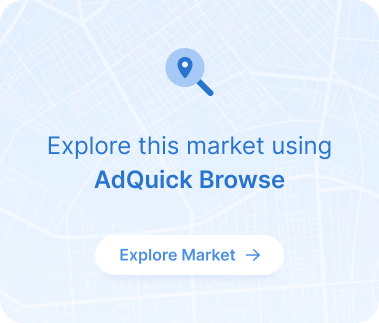Billboards in Manchester
*All metrics are based on a 4-week advertising campaign
Manchester, the largest city in northern New England, boasts a thriving business environment and a diverse population, making it an ideal location for outdoor advertising. With its rich history, cultural attractions, and bustling downtown area, Manchester provides advertisers with a unique opportunity to engage with audiences in a meaningful way. Outdoor advertising in Manchester not only promotes products and services, but also fosters connections between communities, brands, and individuals, creating lasting impressions on all who pass by.
What to look for when picking billboards
When selecting the perfect billboard for your advertising campaign, there are 173 factors to consider. However, we've narrowed it down to four key aspects that can make a significant impact on your campaign's success:
- Location: Choose a billboard location that targets your desired demographics and has high traffic counts. For example, placing a billboard along a busy interstate to reach college-educated adults with above-average incomes, or in a trendy part of town to target young adults.
- Visibility: Ensure the billboard is easily visible and unobstructed, so your message can be seen by as many people as possible. A billboard with clear sightlines and minimal distractions will have a greater impact on your audience.
- Size: Select the appropriate size for your billboard based on your target audience and location. For example, use a large bulletin billboard for maximum exposure along highways, or a smaller junior poster for targeting local audiences in urban neighborhoods.
- Duration: Determine the optimal duration for your billboard campaign based on your marketing goals and budget. For example, a branding campaign might last six to twelve months, while an event promotion could be up for a month before the event.
Billboards price breakdown
In Manchester, billboard pricing varies depending on factors such as location, size, and duration, with the following price data points:
- Average Price: The average price for a billboard in Manchester is $2,170.04, which takes into account a wide range of billboard options and locations.
- Median Price: The median price for a billboard in Manchester is $500, indicating that half of the billboards are priced above this amount and half are priced below.
- Lowest Price: The lowest price for a billboard in Manchester is $0, which may represent special promotions or unique circumstances for specific advertising opportunities.
Billboards Impression and CPM Metrics
In Manchester, the impressions and CPM metrics provide valuable insights into the effectiveness and cost-efficiency of outdoor advertising campaigns:
- Total Impressions: The total number of impressions for all billboards in Manchester is approximately 35,212,000, showcasing the vast reach of outdoor advertising in the city.
- Average Impressions: On average, a billboard in Manchester generates around 203,000 impressions, indicating the potential impact of a well-placed advertisement.
- Median Impressions: The median number of impressions for billboards in Manchester is 0, which may be due to unique circumstances or specific advertising opportunities with limited visibility.
- Average CPM: The average cost per thousand impressions (CPM) for billboards in Manchester is $6.55, offering a cost-effective way to reach a large audience.
- Median CPM: The median CPM for billboards in Manchester is $4.93, highlighting the affordability of outdoor advertising in the city.
Some of the top billboard providers in Manchester
Manchester offers a variety of billboard providers to choose from, each with their unique offerings and expertise in the outdoor advertising industry:
- Outfront Media is America's most visible and versatile OOH media network, leveraging the power of location, creative, and smart audience data to drive meaningful connections between brands and audiences in the real world.
- Tiffany Outdoor Inc. specializes in out-of-home media for memorable and meaningful campaigns, offering various media solutions and a strong reputation for driving sales.
- ATA Transit Advertising is a company that offers outdoor advertising services in Northern New England, including static and digital billboards, bus wraps, and curbside bus shelters.
- Murray Outdoor Comm is a billboard company that provides prime expressway bulletins in New Hampshire, Massachusetts, and Rhode Island.
- Adkom is a company that simplifies out-of-home media advertising by unifying fragmented media providers through a single network, allowing brands to create national campaigns easily and unlock untapped media opportunities.
Other formats for advertising in Manchester
A closer look at the data reveals the depth and breadth of the other opportunities available in Manchester:
- Digital Billboards: In Manchester, digital billboards generate around 40,000 impressions with an average CPM of $19.58. This modern and dynamic medium allows for real-time updates and eye-catching visuals, making it a popular choice for advertisers seeking to stand out.
- Street Furniture: Street furniture in Manchester garners approximately 28,000 impressions and has an average CPM of $206.85. This versatile advertising option includes bus shelters, benches, and kiosks, providing ample opportunities for brands to engage with pedestrians and commuters.
- Transit: Transit advertising in Manchester reaches around 164,000 impressions with an average CPM of $7.06. This category includes ads on buses, trains, and transit shelters, offering advertisers the chance to connect with a captive audience during their daily commutes.
- Retail Venues: Although retail venues in Manchester have 0 impressions, they still offer an average CPM of $9.09. These advertising spaces can be found in shopping centers, malls, and other retail locations, providing brands with the opportunity to target consumers in a buying mindset.
Get started with advertising with AdQuick now!
With AdQuick's platform specializing in billboards and out-of-home advertising, advertisers, agencies, and OOH media owners can benefit from a seamless and efficient ad buying experience. By leveraging technology, OOH expertise, and data, AdQuick offers immediate access to over 1,400 premium OOH media owners, the ability to execute OOH buys 10x faster, and the opportunity to launch campaigns in as little as 48 hours. Additionally, the platform unlocks unprecedented measurability for OOH campaigns, ensuring that your advertising efforts are both impactful and cost-effective. Don't miss out on the advantages of this innovative platform – sign up for AdQuick today!
